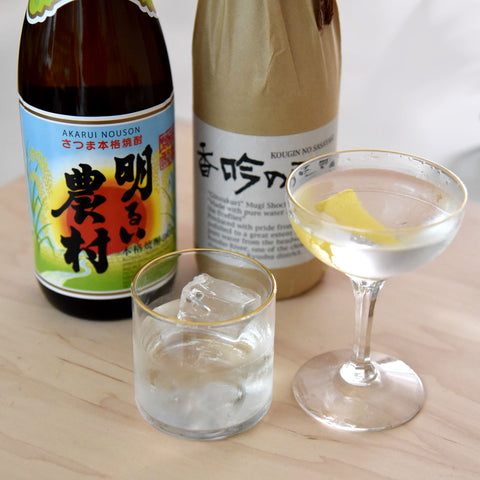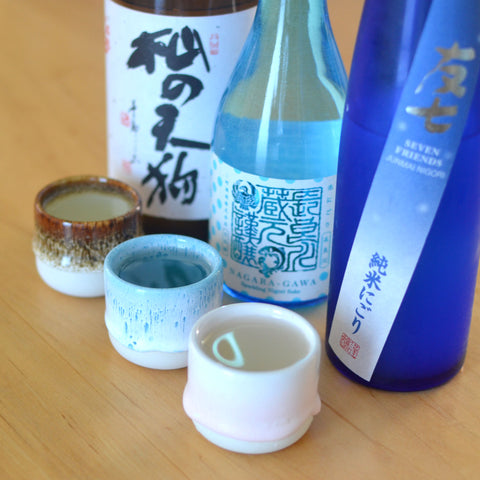 Sake Gumi is our monthly sake subscription service with 200 members throughout California. Join today!
Sake Gumi is our monthly sake subscription service with 200 members throughout California. Join today!
These sakes have all been cooped up, as they age – just like we have this year. That’s why I feel like it's timely to explore jukuseishu, or aged sake, at the end of this particular year. Jukusei means to age or cure and shu is the word for sake. I'm especially prone to enjoy jukuseishu in the winter, as they are excellent warmed up. These aged sakes will also contrast last month's acid-forward sakes, as brewers typically age sakes to reduce acidic flavors in sake.
Brewers will age sake to develop deeper and more well-rounded flavors. Suto-san of Sieryo Shuzo, brewer of Kagiya, sums it up best: "When a sake is new and unaged, you can feel various tastes such as acidity and umami in your mouth. As it ages, each taste merges to become one, resulting in a unified flavor that slowly expands in the mouth. The thorny acid also develops into a rounded body, and the sake grows to become gentle and balanced as a whole." All the other brewers echoed the sentiment, using words like "rich”, “complex”, and “mellow" to describe their aged sakes.
The two main variables when aging sake are time and temperature. The sakes this month age in range from one to three years. Some are aged in controlled, refrigerated environments, which retain some of the fresh flavors of the sake. Others are left out for longer in ambient temperature (anywhere from 32-80°F), which result in fuller, umami-rich flavors, and a slightly amber color. Touda-san of Suwa Brewery, whose Mantensei is aged for at least three years at room temperature, provides a nice description regarding how his sake is aged, "Mantensei goes through the four seasons in Japan and it registers each season in its flavor."
Just in time for the cozy dishes of December, these aged sakes will fit right in when served alongside mizutaki hot pot, pork belly kakuni, cream croquettes, or a juicy steak. We'll recommend a few recipe available on the blog to go along with these sake. Discover them all on the back.
I relate to these bottles – all cooped up and sheltering in place. It's been a challenging year, but I'd like to think that when we are released, we will have a richer, more complex story to tell, just like these sakes.
Yoko
Co-Founder + Sake Director
Umami Mart
LEVEL 1: Introductory Membership (Two 300ml bottles)
 Kagiya Nama Junmai
Kagiya Nama Junmai
Seiryo Shuzo (Ehime, Japan)
Seimaibuai: Ehime Matsuyama Mii 60%, SMV: +3, Aged: 1 yr at ~38°F
Aged in a pitch black refrigerator for one year, this sake is a subtle expression of an aged sake. Suto-san of the brewery describes why they chose to age this sake, “As a young sake, the taste is a bit too green and underdeveloped. Aging it brings out an incredible richness, that also allows it to pair very well with food.” With a soft texture, it has notes of melon, eucalyptus, and white pepper. It also has a very slight golden hue thanks to the aging, but is an overall bright sake that is best enjoyed with lighter dishes like sashimi or mizutaki hot pot. The brewer recommends trying it chilled, then warmed up to 120°F to notice the sweet rice notes of the sake.
 Ichinokura Shozen Jukuseishu
Ichinokura Shozen Jukuseishu
Ichinokura Brewery (Miyagi, Japan)
Seimaibuai: Toyonishiki 85%, SMV: -12~-10, Aged: 3 yrs, 40°F~77°F
This sake was created to pair with beef tongue, a regional dish in Miyagi. Enomoto-san of Ichinokura Brewery says, “We knew that red wine and beef are great companions, so we developed a high-acid sake, but it was too acidic to drink. We made the decision to age it to lighten the acidity.” Age turned the acidity into a rounder, richer, and complex flavor. Because this sake is aged in ambient temperatures that can range from 38°F to 75°F, the amber color of the sake is dramatic. We recommend drinking this sake at room temperature or warm at 110°F with Katei Gyutan Yaki (recipe on the blog), a steak, or an eggplant dish. Bonus points: decantation is recommended when drinking at room temperature to intensify the aroma.
LEVEL 2: Premium Membership (Two 720ml bottles)
 Mantensei “Star Filled Sky” Junmai Ginjo
Mantensei “Star Filled Sky” Junmai Ginjo
Suwa Brewery (Tottori, Japan)
Seimaibuai: Yamada Nishiki & Tamakasae 50%, SMV: +3, Aged: 3 yrs, 32°F~85°F
“This sake is ultimately exposed to 61,320°F, or the average annual temperature multiplied by the number of days this sake is aged – that’s several very cold winters and hot summers spanning three years,” says Touda-san of Suwa Brewery. The result is a savory sake that finishes dry and has a complex minerality. By maturing at room temperature this sake develops a deeper and well-rounded flavor. Try this at chilled (my favorite) or warm it to 110°F (Touda-san’s favorite) to bring out a creamy texture. Serve with a goat cheese from Harley Farms with Kuma Honey on top and you’ve got a ticket to heaven! Touda-san also recommends this sake with cream croquettes.
Nanbu Shuzo (Fukui, Japan)
Seimaibuai: Gohyakumangoku Koshinoshizuku 70%, SMV: +6 , Aged: 1.5 yrs, 40°F~77°F
Everything about this sake screams aged – its amber hue and irresistible flavors of nut and caramel. Takuya-san of Nanbu Shuzo explains, “We aged this sake to get mild and deep flavors. The sweetness mellows out and the off-flavors of youth mature into something rich.” Aging for 18 months at room temperature, brings out earthy notes of prune, vanilla, and cashews that remind me of sherry. Rich dishes like Pork Belly Kakuni, or wild mushrooms sauteed in butter pair well this full-bodied sake. This sake is best hot at 140°F.





Comments (0)
There are no comments for this article. Be the first one to leave a message!